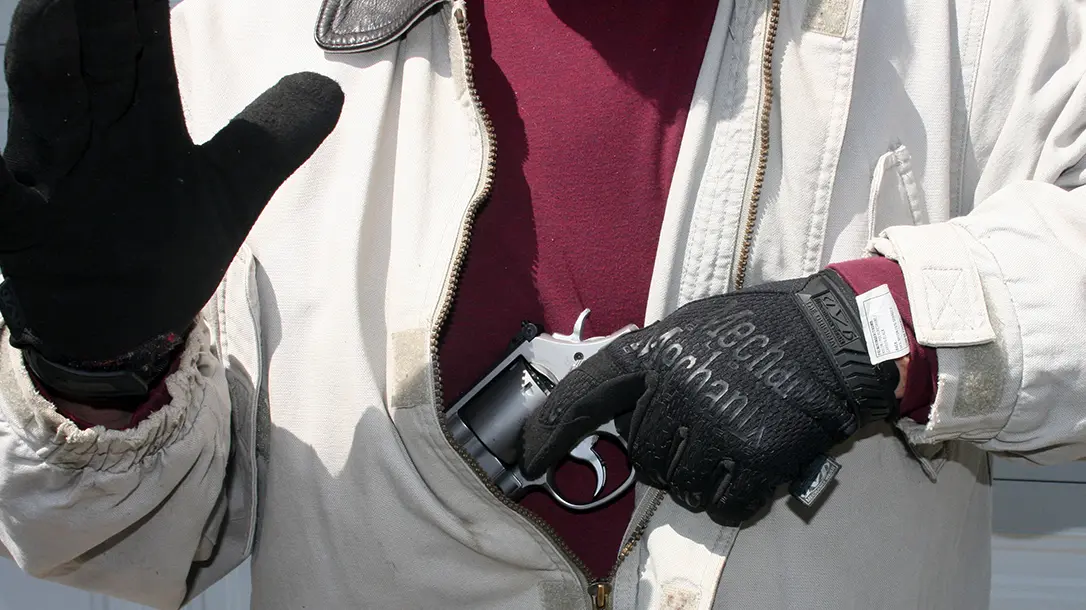The onset of cool weather sets any number of things in motion. We check the anti-freeze level in our vehicle, make sure the furnace is ready to go, and break out the heavy, warm clothing to keep comfortable through the winter. For those of us who carry a concealed firearm on a regular basis, we might also have to make a few adjustments. Let’s take a look at some of the top cold weather carry concerns we all should consider.
Cold Weather Carry Concerns
Like many things in life, there are both advantages and disadvantages to discreetly carrying a handgun in the winter months. During the summer, when shorts and T-shirts are often the uniform of the day, keeping your concealed handgun under the radar can be a challenge. You might be able to dress around the gun to a degree, but in certain social settings and work environments, that’s just not going to work. As a result, some folks take up carrying a mouse gun or forgo carrying any gun at all. The good news is that once the cool weather rolls around, one can hide even a service size handgun with little fuss.
Although a heavy jacket, vest, or sweater can make your gun nearly invisible, quick access can be problematic. This can be further complicated by cold hands and gloves which can play havoc with the draw stroke and execution of the shooting fundamentals. The good news is that for most of us, we can work around all of this.
Advertisement — Continue Reading Below
Holster Considerations
In a perfect world, the most efficient way to draw a handgun is from some sort of belt holster. Personally, I favor an outside the waistband (OWB) holster worn just forward of my strong side hip whenever I can get away with it. I no longer favor traditional inside-the-waistband (IWB) holsters because of a perpetually sore hip, but of late I have utilized an appendix-inside-the-waistband (AIWB) holster on occasion. Although belt carry is generally thought to be the fastest, most efficient way to draw a handgun, exactly how do you accomplish this when your jacket is zipped up to the neck?
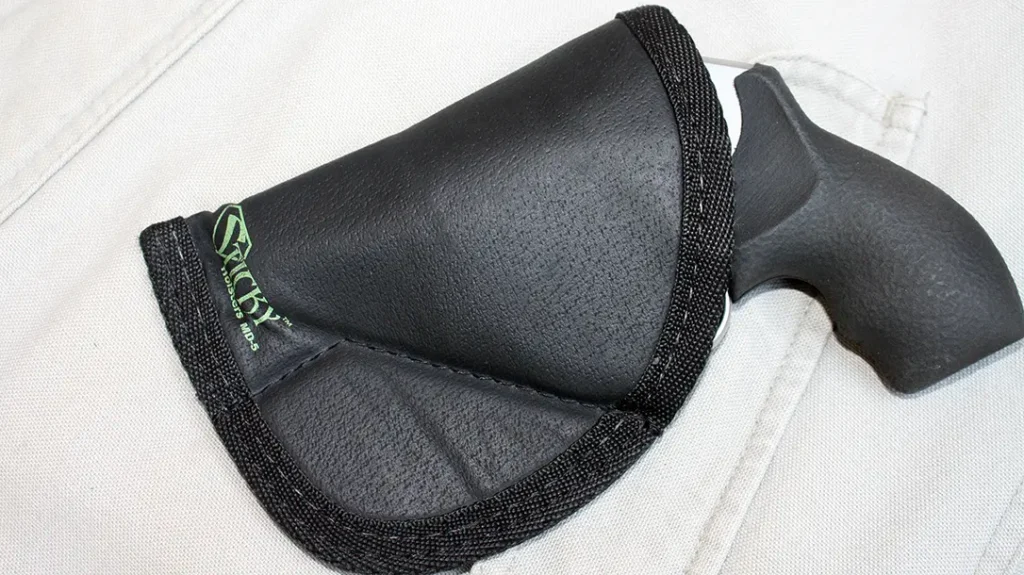
First, let’s consider how we define cold weather. In my part of the world, a 40-degree day in February might be considered a heat wave, as more often than not the mercury is typically below freezing. If you spend any amount of time outdoors, a heavy jacket and multiple layers of clothing are often worn. This, of course, makes quick access to a handgun contained in a belt holster a challenge. Considering that an attack can unfold in the blink of an eye, not being able to quickly get your gun into action is problematic
Advertisement — Continue Reading Below
Access Is Everything
Do you practice drawing your handgun from the holster and clothing you actually wear when going about your daily routine? Well, you should! If a heavy winter jacket is an integral part of your wardrobe and you neglect practice, your concealed handgun is about as useful as a hood ornament for a good part of the year.
Think of outer garments as either closed front or open front. An example of a closed front garment is a hooded sweatshirt, while a jacket with a zipper or buttons not completely fastened falls into the open front category. These types of outer garments require a slightly different drawing technique for each.
Keep it Casual
I confess I often exercise considerably more latitude in my attire than most. The clothing I wear on a daily basis trends toward loose and casual. In the cooler months a hooded sweatshirt with an unzipped vest over the top often gets the call. To draw, I use my support hand to lift the bottom of the “hoodie” up to chest level as the strong hand goes to the gun. Should you favor a closed front garment, putting in a little practice time with an unloaded gun (check it twice!) will get you on the fast track. Should a threat appear inside your personal space, you may however, need that support hand to block.
Advertisement — Continue Reading Below
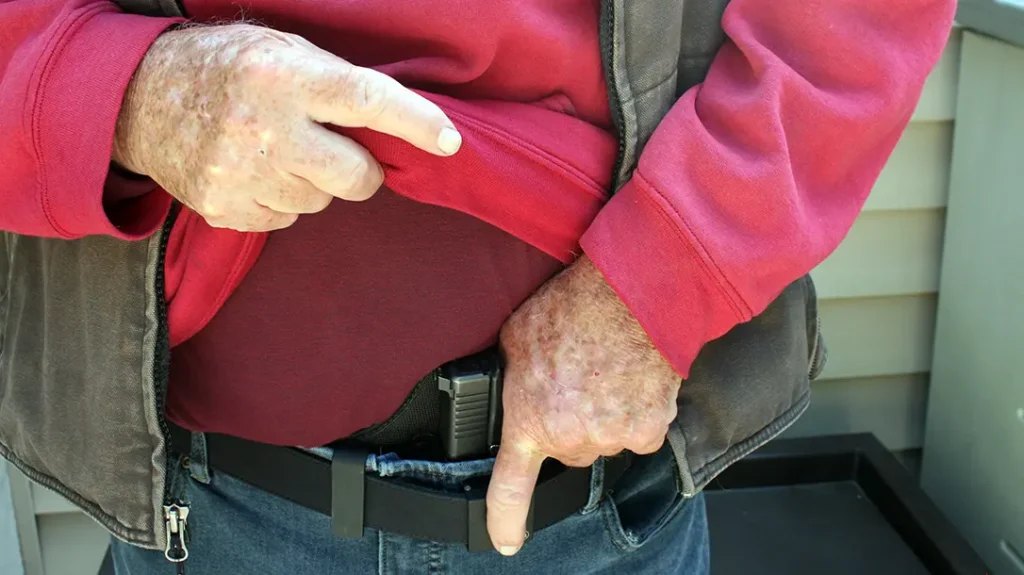
In those types of situations, the strong hand has to lift the garment and quickly come back to the gun. More than likely, shooting will be done using a retention technique to prevent your adversary from grabbing your gun. Once you are comfortable with the technique and confident that you are doing it safely, you can move on to live fire.
Garments with zippers or buttons extending below waist level present special issues when closed up. If that’s the case, producing the gun from the belt is a non-starter. With an unfastened front, one can sweep the jacket clear with the strong hand and go for the gun. Unfortunately, harsh winter weather often has us zipping up, and when that’s the case we may have to look at some alternative carry modes.
Advertisement — Continue Reading Below
The Shoulder Holster Alternative
Some years ago I was teaching a concealed carry class to a group of law enforcement officers when the subject of shoulder holsters came up. I opined that I thought shoulder holsters filled a specialized niche and not the best choice for general carry. At that time, an old school retired detective from Chicago spoke up and told the group why he favored a shoulder rig. As anyone who has visited the Windy City during the winter months can tell you, temperatures below freezing are the rule. Trying to quickly draw a revolver buried beneath a suit jacket and overcoat was next to impossible. This gentleman discovered that by leaving the top buttons of his overcoat unfastened, he could produce his handgun very quickly in time of need.
My modest collection of holsters includes of few examples of shoulder holsters, both in vertical and horizontal styles. Among my favorites are the Galco Miami Classic Shoulder System and the Jackass Rig Shoulder System. Both of these holsters allow me to discreetly carry a medium size-handgun under a winter jacket. Efficiently drawing a handgun from a shoulder holster is indeed a little different and something that needs to be practiced. I still prefer to carry my pistol on the belt whenever possible, but for winter carry, a shoulder rig may warrant some serious consideration.
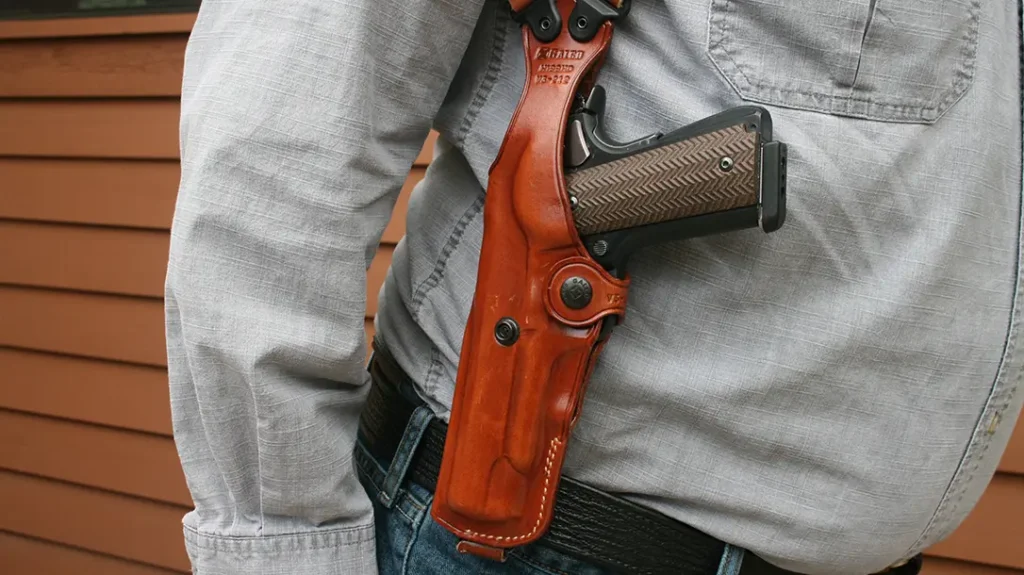
Advertisement — Continue Reading Below
In the Pocket
Pocket holsters see wide use to carry a small handgun when belt carry proves outside the realm of possibility. More often than not, a small handgun, along with the holster, conceals inside the pocket, the end result producing a very low-profile system. For cold weather carry, there is yet another dimension we could explore.
Could such a rig work if placed in the pocket of an outer garment? Absolutely! Dropping a pistol into the pocket of your winter jacket can give you a huge advantage over trying to access your gun off the belt. In cold winter weather, not many people are going to give a second thought if they spot you with hands in your pockets. With your hand wrapped around the grip of the gun, draw times can be very quick. I would caution that many of these holster designs work from inside a pants pocket. During the draw, the holster hooks inside the pocket when presenting the gun on target.
Placing this same rig in the coat pocket may yield very different results with both gun and holster coming out as a single unit. If you choose to go this route, just make sure your chosen holster catches on the top of the pocket of your jacket and separates at the moment of truth.
Advertisement — Continue Reading Below
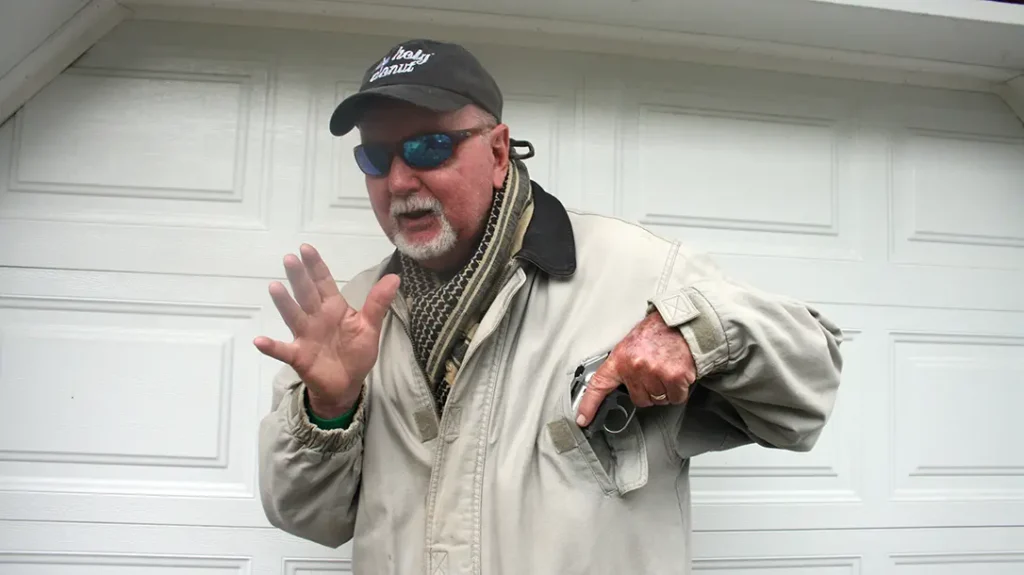
Cold Hands
Cold weather plays havoc with the dexterity of the hands and fingers, critical elements to manipulating the controls and firing a handgun. In other endeavors, wearing gloves is the obvious solution, but this is yet another challenge when running a handgun. I spent a good part of my career conducting training outdoors during the winter months, and I have yet to stumble across the perfect solution. Gloves designed to keep your hands warm during cold weather are often too bulky for shooting and performing basic operational skills.
Thinner gloves may not keep your hands warm for extended periods of time in harsh weather but may help your cause. For several years I have utilized gloves from Mechanix Wear who offer a few different styles. It may not feel the same as a bare hand on the pistol, but I can draw, work the trigger, and reload without too much fuss. They wouldn’t be my choice for snowmobiling, but they will take the bite off when the temperatures get low.
Advertisement — Continue Reading Below
How Does Your Ammo Stack Up?
The handgun ammunition we have available to us today represents a quantum leap over that of just a generation ago. I have long made a strong pitch that carry guns should be chambered for a service cartridge and come from a reputable manufacturer. You should select an offering with a solid street reputation and good reference point to see what sort of loads the cops are carrying.
More often than not, individuals who take up the gun for personal defense choose ammunition loaded with a hollowpoint bullet. But as we have found out in the last 30 years, just because the bullet has a hollow cavity does not make it a good performer. In extensive testing conducted by the FBI and others, it was determined that barriers common in shooting incidents can be formidable obstacles to bullet performance. We can all appreciate that obstacles such as sheet steel or windshield can inhibit bullet performance, but heavy clothing too can foul a hollowpoint bullet, totally preventing expansion and making it behave much like ball ammunition.
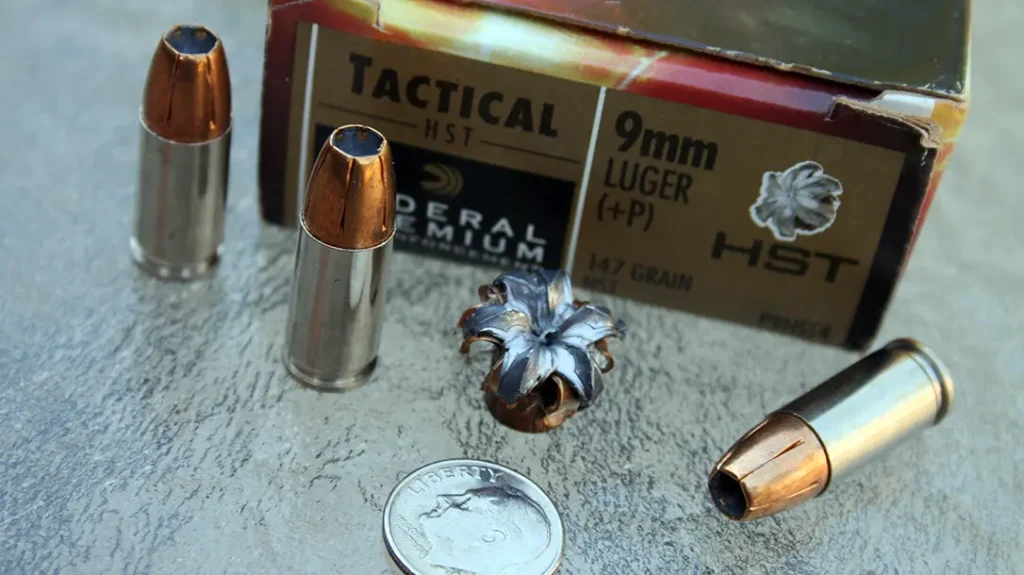
Advertisement — Continue Reading Below
The good news is that the ammunition manufacturers have solved the riddle. Rounds such as Federal HST, Hornady Critical Duty, Remington Golden Saber, Speer Gold Dot, and Winchester Ranger are all top performers, and in my informal testing, expand to 1.5 times their original diameter when fired through four layers of denim into ballistic gelatin. When your life could be on the line, go with a proven winner.
Final Thoughts
Bear in mind danger doesn’t take a holiday just because it got cold outside. Where I live in the northeast U.S., a jacket or sweatshirt is worn a good part of the year, and my practice typically involves drawing from concealment. The good deal about draw practice is that it can be practiced in your home with an unloaded handgun. This is especially important in view of the fact that many commercial ranges prohibit drawing from the holster.
So team, give that winter carry combination some serious thought and make adjustments as necessary. It may take you a tad longer to get into action, so it’s even more important to spot the danger sooner. Stay switched on!
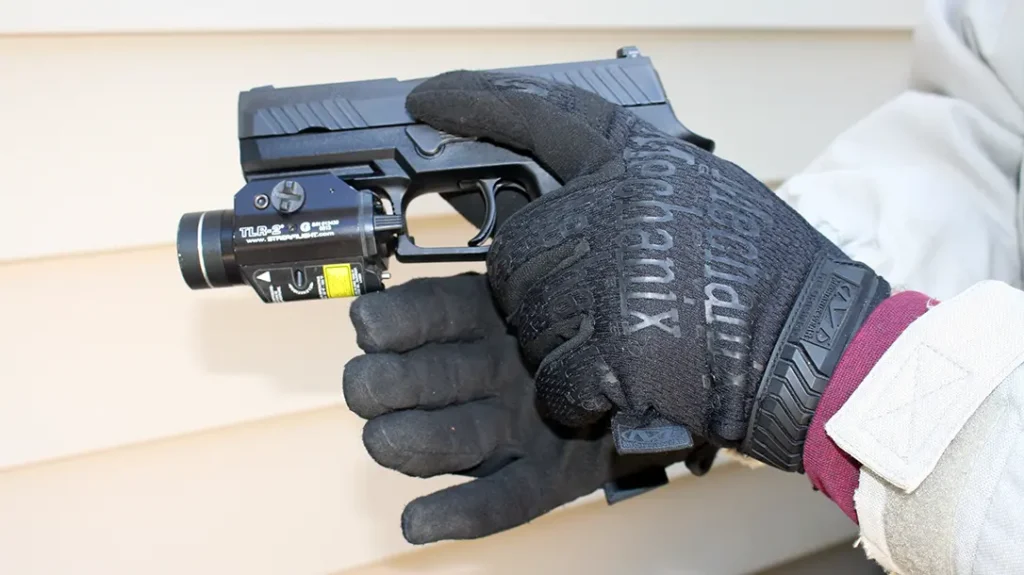
Find a place to shoot at NSSF.org.
